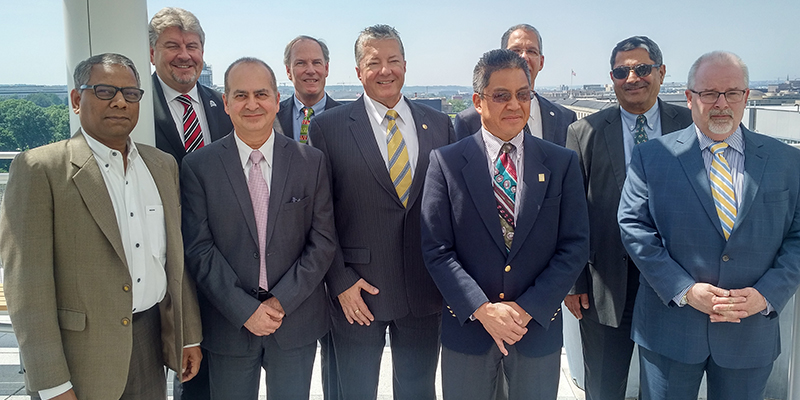
 |
| IAS Board completes leadership transition; continues mission to grow U.S. and global presence. |
SHARE    |
 |
| IAS Board members at the IAS Board meeting on May 26 in Washington, D.C. Not pictured: IAS Board member Craig Morr (NSF). |
| In April, the IAS Board of Directors transitioned to new leadership for the first time in six years, a move that outgoing and incoming executives believe will further build on IAS's brand in the U.S and around the world. Last year, John Barrios and Isam Hasenin elected to step down from their respective chair and vice chair positions, making way for James (Jim) Toscas, P.E., president and CEO of the Portland Cement Association (PCA); and Rocco Davis, vice president and regional manager of the Pacific Southwest Region of the Laborers' International Union of North America (LIUNA), to take over as chair and vice chair, respectively. Toscas and Davis assume leadership of an organization that is financially strong, internationally respected and a recognized leader in accreditation services — thanks in large part to the people that have come before them. Building the Brand Barrios, the Manager of the Construction Services Division for the city of Tampa, Fla., joined the IAS Board in 2006 and became chair in 2010. Hasenin, P.E., CBO, COO with Bureau Veritas North America, joined the IAS Board in 2008 and became vice chair alongside Barrios in 2010. Under the guidance of Barrios and Hasenin, the IAS Board has helped direct the organization through unprecedented growth. Since 2010, IAS has accredited almost 900 agencies and expanded the IAS brand around the world. Barrios recalls, "I'm proud to have seen this relatively small company grow in size by a factor of four in the last decade — and we've done so without sacrificing our commitment to quality and outstanding customer service. Full credit goes to Chuck and his staff, who set the standard for commitment, hard work and proficiency. Chuck has a way of inspiring everyone to rise above and do more for public safety and the built environment around the world." Reflecting on those early days, Hasenin agrees, adding, "I joined the organization because I was impressed with Chuck's ethical standards and professionalism, as well as the reputation of the organization. Our job was to make sure we maintained those high ethical standards while growing our global footprint of IAS through outreach and building a network of highly qualified and trusted assessors. It's been a truly enriching experience." Perhaps most impressive, Barrios, Hasenin and many others were instrumental in helping Ramani (founder-president of IAS and nonvoting member of the IAS board) literally change the face of IAS. Since inception in 1975 to the early 2000s, the IAS Board was primarily comprised of representatives from the government sector — no public, industry or labor members. Today, the IAS board is represented by all those sectors — public, private, union, non-union, profit and non-profit. Hasenin says, "The diversity of the board in terms of background, experience, geographic locations and industries have tremendously helped us come up with new ideas, generate good discussions, improve productivity and make good decisions about the direction of the organization. Really, this was a genius move on Chuck's part." New IAS Board Chair Toscas believes the broad mix of industry representation will continue to have a major impact on the trajectory of the organization. He says, "While diversity does not always guarantee success, Chuck has encouraged involvement from industry leaders who work well together to strategically expand the organization beyond the U.S. borders." Currently, the IAS international business is just under 50 percent of IAS's total revenue stream. Outgoing Chair Barrios, agrees, "We've met so many of the goals we set in 2010 because of our diverse team — and we're proud of those accomplishments. I'm proud to hand the reins over to the Jim and Rocco. Like any organization, new leadership creates a platform for the continued advancement of our strategic plan to raise the bar through accreditation in the built environment." Accreditation Moving Forward Toscas, who first joined the board in 2008, believes his role as chair of the IAS Board is more of a process leader. It's imperative that IAS, as a group, continues to grow the IAS brand, particularly in light of current industry trends and challenges. He points to the rising need and demand for accreditation as a differentiator. "In today's digital world, organizations can form and disappear seemingly overnight. The more alternatives that are presented, the more important it is to have a way to evaluate those alternatives," says Toscas. "That's the role of an internationally recognized accreditation process. Accreditation becomes ever more important the more complex the world gets and the more alternatives are presented." Vice Chair Davis, agrees adding, "Accreditation assures owners and the public that they're getting what was promised. It raises the standard of best practices, and creates a baseline for the minimum acceptable product or solution." One item on the current agenda for Toscas, Davis and the rest of the IAS Board will be to find a way to improve workforce qualifications as a way to address emerging workforce challenges. What can IAS do to better the workforce qualification process today and tomorrow? Ramani concludes, "We've got a lot of work ahead of us to do our part to develop and prepare tomorrow's workforce, build on our trusted accreditation model and raise the bar on the way we build. Thanks very much to John and Isam for their time, dedication and leadership. We would not be where we are today, without them." |